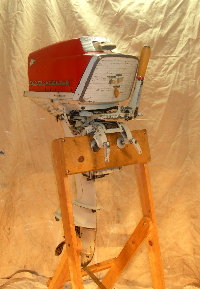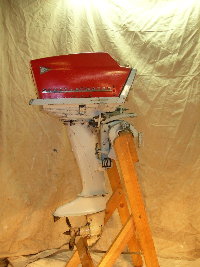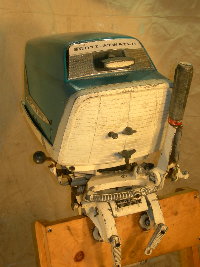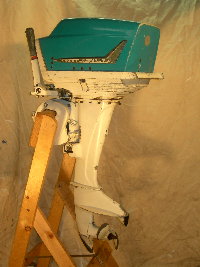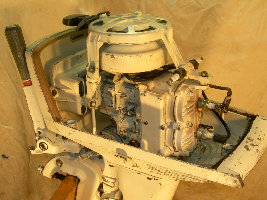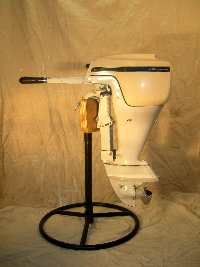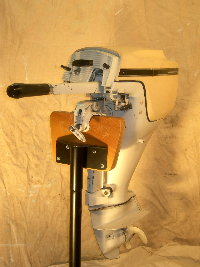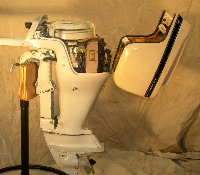Harry's Corner
PIE
RAT MOTORS MOTORS
1957
Scott Atwater 7.5 hp. |

|
Year & Model:
1957 Scott Atwater 3375
Horsepower: 7.5 @ 4,200 rpm
Cylinders: 2
Bore: 2"
Stroke: 1.75"
Ignition: Repco
Point Gap:.020
Cooling: Water by impeller
Condition: Unrestored
Retail price when new: $260.00
Weight: 60 lbs.
Oil/Gas Mix: 1/2pt TCW-3
Spark Plug: Champion H10 (now H10C)
|
|
|
1958
Scott Atwater 7.5 hp. |
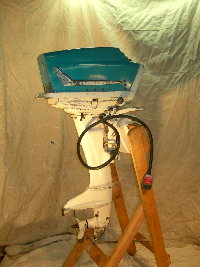
|
Year & Model:
1958 Scott Atwater 3385
Horsepower: 7.5 @ 4,200 rpm
Cylinders: 2
Bore: 2"
Stroke: 1.75"
Ignition: Repco
Point Gap:.020
Cooling: Water by impeller
Condition: Unrestored
Retail price when new: $277.25
Weight: 60 lbs.
Oil/Gas Mix: 1/2pt TCW-3
Spark Plug: Champion H10 (now H10C)
|
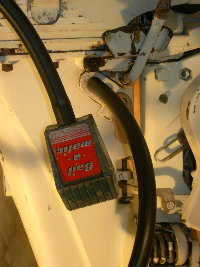 Closeup
of the Bail-a-Matic bailer
Closeup
of the Bail-a-Matic bailer |
|
|
|
1968
Sears Ted Williams 7 1/2hp
by McCulloch. |
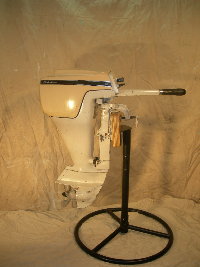
|
Year & Model:
1968 Ted Williams
Horsepower: 7.5 @ 5,000 rpm
Cylinders: 2-Alternate Firing
Bore: 1 .9375"
Stroke: 1.7"
Ignition: McCulloch Magneto
Point Gap: .020
Cooling: Water by rubber impeller
Condition: Unrestored
Retail price when new: $267.00
Weight: 48 lbs.
Oil/Gas Mix: 1/2pt TCW-3
Spark Plug: Champion H-10 (Now H-10C ) |
|
|
|
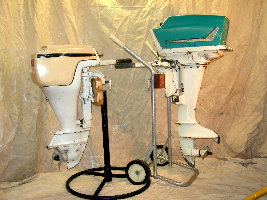
This
photo dramatically shows the difference in size between the low profile
7.5hp Scott/McCulloch & the previous model 1958 Scott Atwater
7.5
|
Dad's
view:
Low-profile fishing motors became all the rage in the 1960's, OMC came out with
the 9.5 "squat" motors in '64 and Chrysler got into the act in the
late 60's. However, in 1959 Scott/McCulloch was the trend-setter with the 7.5hp
Fishing Scott, the first motor on the market of this design. (Okay, in fairness,
the '46 to '57 Flambeau, '38 to '40 Clark Troller
and '36 to '40 Bendix motors were earlier attempts
at low-profile outboards.)
The goal of making
a low-profile, compact and very light weight motor were definitely achieved
by Scott/McCulloch. And, to improve on a major shortcoming of the Bail-a-Matic
motors, they even moved the waterpump and bailer impellers down below the waterline.
Keeping the waterpumps below the waterline helped improve their longevity over
the previous model.
The downside with
all the low-profile motors is that they are IMPOSSIBLE TO WORK ON!!!!!!
To do just about anything on this motor (carb, waterpump, shift
linkage) you need to remove the powerhead. Accessing the fasteners holding the
powerhead to the tower is a challenge since you first need to take just about
every darn part off the motor. The waterpumps are mounted upside down on the
spray plate and you need 3 hands to work on them. There is also a fair amount
of plumbing for the bailer and cooling systems with press-fit connections, all
possible places to leak and reduce cooling water flow. There are other screwy
things like the tiller that folds down - a problem when you go to tilt the motor
up since it hits on the seat of your boat. All of these motors have problems
with the motor cover being cracked, broken or missing. This is because the cover
is made from the cheapest, flimsiest plastic I have ever seen. Even when new,
the cover, latches and hinge were not strong enough to support anything - I'm
sure more than one broke on the showroom floor! Add 40 years for the plastic
to get brittle and you have one really fragile item. If you have one of these
motors never, ever, use the hand-hold provided in the back of the cover to tilt
or cary the motor.
Despite the fact
that the Ted Williams seen above came to Harry in pretty good shape, it needed
a lot of work to get it operational. I have worked on a lot of motors over the
years and this one is, without a doubt, the hardest and most challenging outboard
I have ever dealt with. In addition to the wacky waterpumps, the carburetor
and float are bizarre - the latter needing a ton of tiny intricate gaskets.
I was able to find some new impellers but all the other parts like the carb
gaskets I had to make. Other parts that were broken or missing needed to be
gleaned off parts donors.
Should anyone
attempt to restore one of these, my suggestion is to have at least 2 donor motors
for parts. As with earlier Scott's, every fastener tends to fuse into whatever
it is screwed into. A lot of PB Blaster (or like product) and heat is required
but some of the fasteners are impossible to get at. (and they are the ones that
are the most stuck!) I had particular trouble with the lower rubber vibration
mounts coming apart, they must be unfastened to do the waterpump. It took a
number of tries to get a useable one off the parts motors - they kept breaking.
Back to
Oddjob Motors
